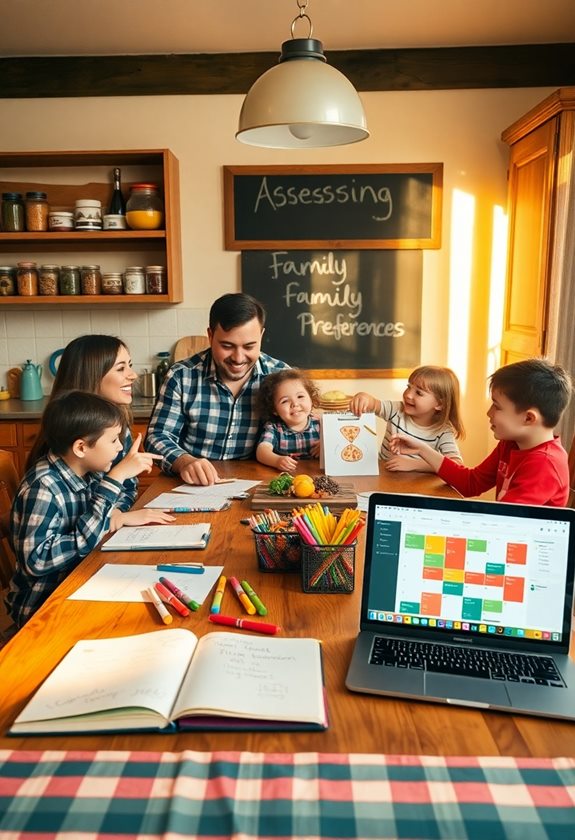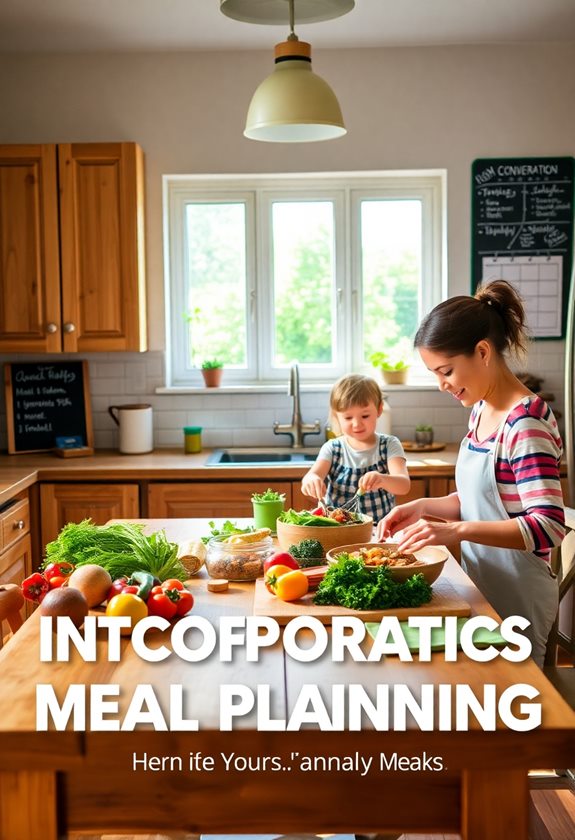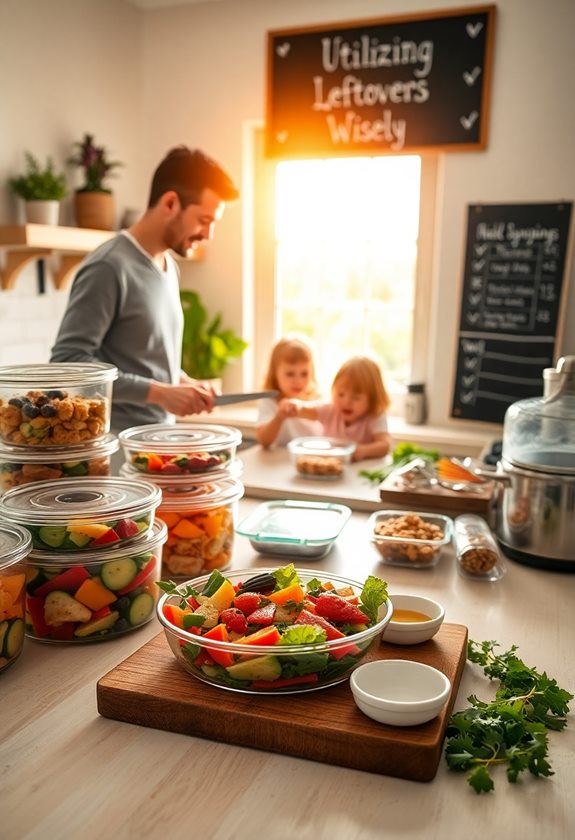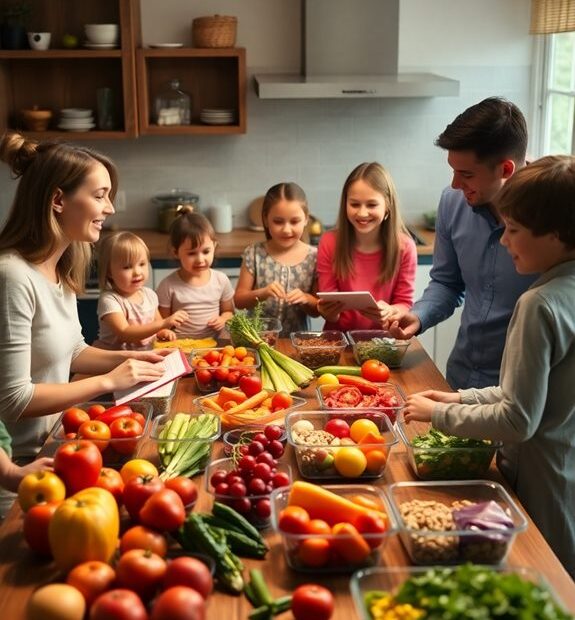Creating a successful family meal plan is easier than it seems! Start by chatting with your family about their favorite foods—this helps avoid meals no one enjoys. Have you thought about using a weekly menu? It can cut down on last-minute stress. Quick recipes are lifesavers, especially on busy nights. Consider batch cooking to save time for future meals. And don't forget about leftovers! They're great for new dishes. Involving your kids in planning and cooking makes it fun and encourages them to try new foods. Want to discover even more handy tips for stress-free meal planning? 🌟
Key Takeaways
- Engage family members in discussions about their favorite foods and dietary restrictions for inclusive meal planning.
- Create a structured weekly menu to simplify cooking and reduce stress during busy days.
- Incorporate quick recipes and one-pot meals to save time and effort on weeknights.
- Utilize batch cooking strategies to prepare large portions and make meal access easier.
- Involve kids in meal planning and cooking to foster healthy eating habits and family bonding.
Assessing Family Preferences

When it comes to planning meals for your family, understanding their likes and dislikes is essential. You wouldn't want to serve macaroni and cheese if your kids can't stand it, right? Start by chatting with them about their favorite foods. Maybe one child loves tacos, while another prefers pizza. This kind of conversation helps you get a clear picture. Utilizing a meal planning tool can also streamline this process, ensuring you cater to everyone's preferences effectively.
Next, consider any dietary restrictions. Does anyone have allergies or dislikes? You wouldn't want to accidentally make a dish that could cause a problem. Keeping a list of these preferences can be helpful.
You can also involve your family in the cooking process. Ask them to help choose recipes or even cook together. This makes meals more fun and encourages them to try new things.
Creating a Weekly Menu
A well-structured weekly menu can simplify your meal planning and make your family's dining experience more enjoyable. Have you ever found yourself staring into the fridge, wondering what to cook? Creating a menu helps you avoid that stress! A thoughtful meal plan not only enhances healthier eating habits but also promotes mindfulness regarding nutritional content, aligning with your family's dietary preferences. the power of meal planning
Start by setting aside a little time each week. Grab a notebook or use an app to jot down ideas. Consider your family's preferences—what do they love? Maybe taco night is a hit, or perhaps your kids can't get enough of pasta. 🍝
Next, balance your meals. Aim for a mix of proteins, veggies, and grains throughout the week. For example, you might plan grilled chicken with steamed broccoli on Monday, and a veggie stir-fry on Tuesday.
Don't forget about leftovers! They can save you time and energy. If you make a big batch of chili, enjoy it again later in the week.
Lastly, involve your kids in the planning. Ask them what they'd like to eat and let them help pick meals. This not only makes them feel included but also encourages healthy choices. Remember, meal planning doesn't have to be perfect—just make it work for your family!
Incorporating Quick Recipes

Everyone knows that life can get busy, and sometimes you need meals that come together in a flash. Quick recipes are your best friend! Think about those nights when you're juggling homework, activities, and dinner. What if you could whip up something tasty in just 30 minutes? Incorporating tools like the Mueller Pro-Series 10-in-1 Vegetable Chopper can make vegetable prep a breeze, allowing you to spend less time in the kitchen and more time with your family.
Start by keeping a list of your family's favorite quick meals. Simple dishes like stir-fries, tacos, or pasta can be ready in no time. For instance, you can sauté veggies and protein in a single pan, add some spices, and serve it over rice. Easy, right? 🍲🍝
Don't forget about one-pot meals! They save time on cooking and cleanup. Plus, you can toss in whatever ingredients you have on hand. How about a hearty soup? Just throw in some broth, chopped veggies, and beans, and let it simmer while you help with homework.
Stock your pantry with quick staples, too. Canned beans, frozen veggies, and quick-cooking grains can make meal prep a breeze. By planning ahead and keeping things simple, you'll find that quick recipes can still be delicious and satisfying. Who says fast food can't be homemade?
Batch Cooking Strategies
Batch cooking can transform your weekly meal prep, saving you time and stress. Imagine coming home after a long day and knowing dinner is already sorted! By planning ahead, you can cook large portions of food in one go and store them for later. It's a real lifesaver for busy parents like you.
Here's a simple table to guide your batch cooking strategy:
| Food Type | Batch Cooking Ideas |
|---|---|
| Grains | Cook rice, quinoa, or pasta in bulk. Store them in the fridge for quick meals. |
| Proteins | Roast chicken, bake tofu, or prepare beans to use in various dishes. |
| Vegetables | Steam or roast seasonal veggies and keep them ready to toss into meals. |
| Sauces & Soups | Make large batches of sauces or soups to freeze and reheat as needed. |
What do you think? Wouldn't it be great to have these meals ready to go? By dedicating just a few hours once a week to batch cooking, you'll make mealtime easier and more enjoyable for your family. Give it a try! 🍽️
Utilizing Leftovers Wisely

After you've put in the effort of batch cooking, don't let those leftovers go to waste! You've created a treasure trove of meals just waiting to be enjoyed again. So, how can you make the most of them?
Start by storing leftovers properly. Use clear containers and label them with dates, so you know what's what. This way, you won't forget what's in your fridge! 🥡
Next, think about how you can repurpose those meals. Leftover chicken can become a tasty chicken salad or a hearty soup. Got extra veggies? Toss them into an omelet or stir-fry for a quick meal.
You can also freeze leftovers for later. Just portion them out into single servings for easy access. This is a lifesaver on those busy nights when cooking feels overwhelming.
Lastly, don't forget to get creative! Challenge yourself to make a "leftover night" where everyone picks their favorite dish. It's fun and helps you clear out the fridge. So, the next time you finish cooking, remember: those leftovers are not just food; they're a chance for new meals! 🍽️
Involving Kids in Planning
Involving kids in meal planning can transform dinner time from a chore into a fun family activity. When you let your children help choose meals, they feel valued and excited to eat what they've picked out. Plus, it's a great way to teach them about nutrition and cooking!
Here are some easy ways to get your kids involved:
- Create a meal calendar: Let them pick a few meals each week. It'll give them ownership over dinner.
- Go grocery shopping together: Turn it into an adventure! Ask them to help find healthy ingredients on your list.
- Cook as a team: Let them assist with age-appropriate tasks, like washing veggies or stirring pots.
Doesn't it sound fun? You'll bond while teaching them valuable skills. Plus, they're more likely to try new foods when they're part of the process. Remember, it's not just about the food; it's about the memories you create together. So, why not start today? Make meal planning a family affair and watch as everyone enjoys dinner time a little more! 🍽️

